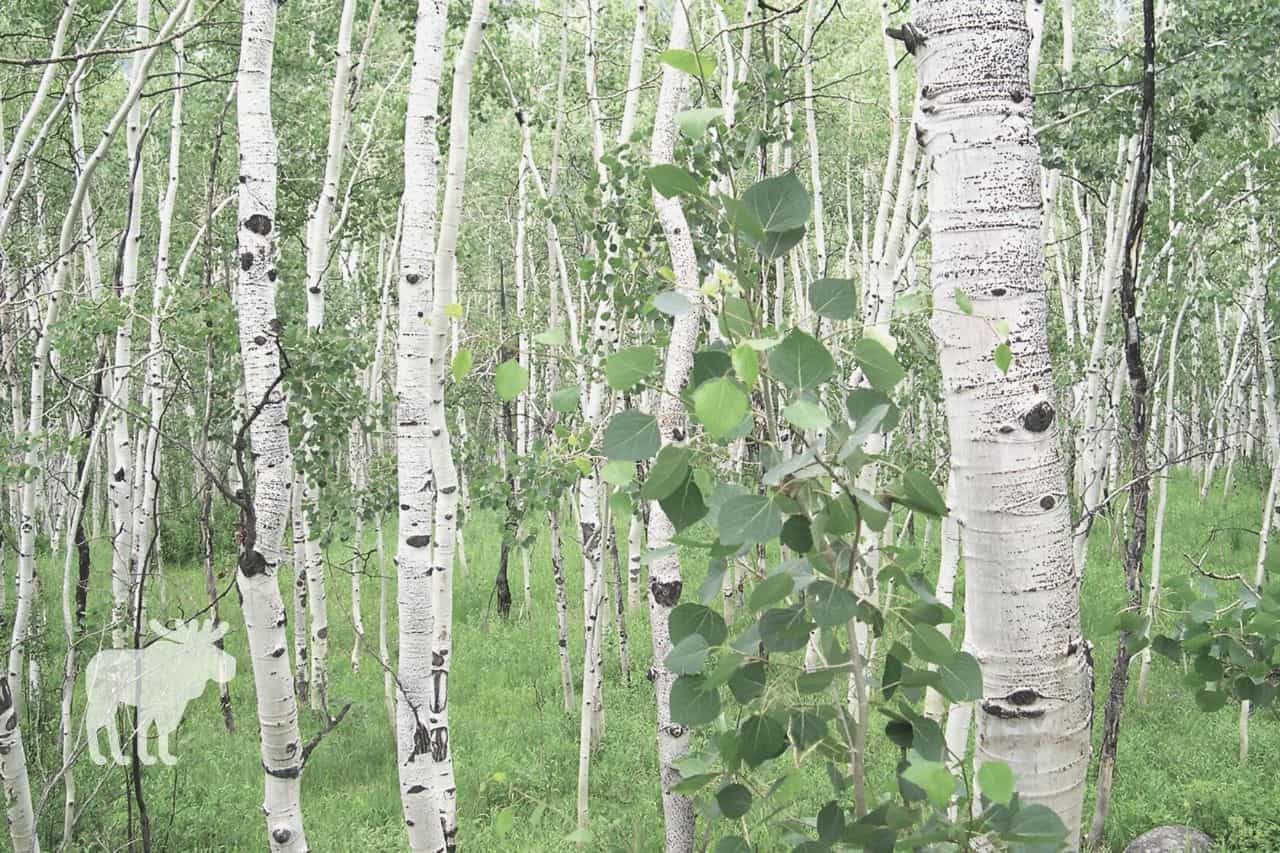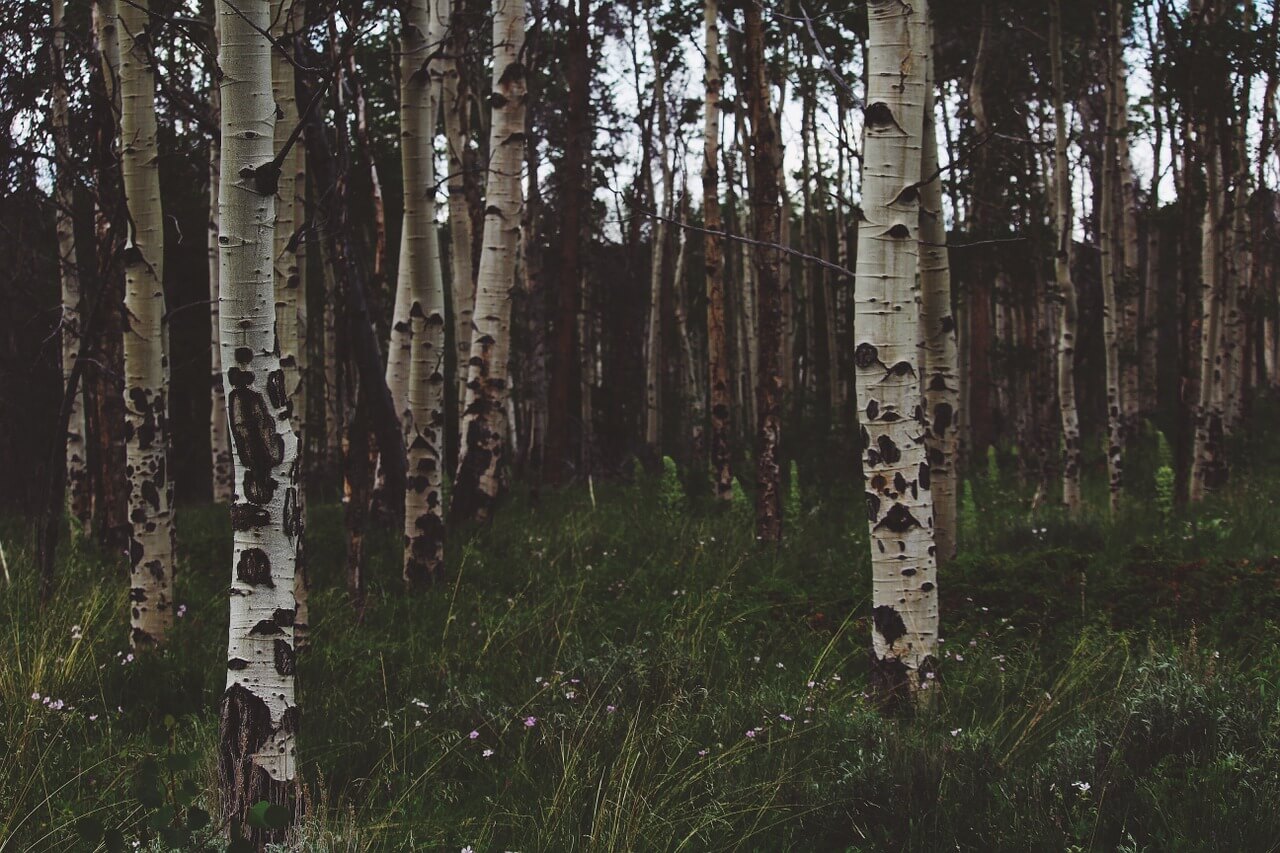Tall white trunks, beautiful yellow foliage, great ornamental value. There’s a lot to love about aspen and birch trees. But they can look so similar to each other, you may be wondering how to tell them apart. In this article, we’ll compare the similarities and differences of the aspen tree vs. the birch tree.
What You'll Learn Today
What is an Aspen Tree?

An aspen tree doesn’t exist on its own; rather, it is part of a much larger network of trees that grow together and share the same root system.
According to the National Forest Foundation, every tree in a network of aspens is genetically identical to all the others; thus, a stand of aspens trees is referred to as a “clone” of aspen trees.
Aspens are known for their beautiful white trunks and shimmering leaves. The leaves are a dark, shiny green in the summer and turn a bright yellow in the fall.
Aspens often grow around the edges of pine forests, with their white trunks and yellow fall foliage providing a striking contrast to the evergreens. They require full sun and moist soil to grow, though they can grow in a variety of soil types.
Aspen trees can be found throughout the United States and northward into Canada.
What is a Birch Tree?
From a distance, birch trees look strikingly similar to aspen trees. There are many different subspecies of birch, and many of them have white bark and leaves that turn bright yellow in the fall.
Birch tree leaves are usually a bright yellow-green in the summer and will turn vibrant shades of red, orange, or yellow in the fall. Their trunks may be white, black, silver, yellow, or even red depending on the species.
Birch trees often have thin, papery bark that peels away in sheets. These sheets are lightweight but strong and are used in a variety of crafts and projects; historically, they were even used by Native Americans to make canoes.
Birch trees often grow singly or in small, unconnected groups, though sometimes it will appear that several trees are growing from the same root system. This is because a single tree will sometimes have several trunks growing from the tree’s base.
Aspens can grow in partial shade, but they require loose, loamy soil to thrive. They also tend to prefer colder environments, as they are primarily found throughout the northern and eastern parts of the United States and Canada.
Aspen Vs. Birch: Similarities and Differences

Aspens and birches are often confused and mistaken for the same tree. Though they have many similarities, they also have their share of differences.
Let’s discuss these similarities and differences below.
Similarities
- White bark: Aspens and many types of birches both have white bark. From a distance, their tall, narrow, white trunks can appear very similar despite that they are completely different types of trees.
- Yellow leaves: Both aspens and many types of birches produce brilliant yellow fall foliage. The bright yellow leaves often provide a beautiful contrast to the evergreen trees in the area as well as the more muted colors of other deciduous trees.
- Height: Both birches and aspens can grow quite tall. Birch trees can grow up to 70 feet tall, while some aspen trees can reach heights of 80 feet.
- Medicinal value: Both birch and aspen have been traditionally used for medicine (though there is little scientific evidence to support their use). Birch has been used for ailments such as kidney stones and joint pain, while aspen has been used for both joint and nerve pain, as well as prostate and bladder issues.
Differences
- Scientific families: Birch contains up to 60 subspecies, while aspens contain only a few. Birch trees belong to the Betula genus, while aspen trees belong to the Populus genus.
- Distribution: Aspen trees are found all over the United States and Canada, from the cold northern regions through the Midwest and into the mountain and desert regions of the West. Birch trees have a more limited range, as they are found primarily in the eastern and northern regions of the United States and Canada.
- Flammability: Oddly enough, aspen wood is not as flammable as other types of wood and, for this reason, is often used to make matches. Birch wood, on the other hand, is highly flammable and, thus, makes excellent firewood.
- Growing conditions: Aspen trees can grow in many different soil conditions as long as the soil is moist and they receive full sunlight. Meanwhile, birch trees need good loose soil to grow, but they can grow in areas that receive partial shade.
How to Tell an Aspen Apart from a Birch
- Look at the leaves: In the summer, aspen tree leaves are generally darker green than birch leaves.
Also, if you look at the leaves closely and compare them side by side, you will see that they differ in shape as well. Aspen leaves are more rounded and heart-shaped, while birch leaves are more triangular, pointed and jagged.
- Look at the bark: Birch bark is somewhat papery and peels away from the trunk rather easily. On the other hand, aspen bark is wrapped tightly around the trunk and will not peel away easily.
- Look under the bark: If you peel away a layer of birch bark, you will discover the trunk underneath is also white. If you cut away the top layer of aspen bark, you will find a soft, green layer underneath.
- Look at a map: If you’re anywhere in the western or southern parts of the United States, then you probably have aspens rather than birches. If you’re in the eastern or northern areas, you may have both aspens and birches and will have to use other means to tell them apart.
Check out this video to get a good visual of the similarities and differences of birch and aspen, as well as the similar-looking poplar trees.
Conclusion
Aspen trees and birch trees look very similar from a distance thanks to their white trunks and yellow fall foliage, but they are actually quite different from each other. Not only are they completely different types of trees, but they also require different growing conditions, have differences in distribution, and even have different levels of flammability.
Good article I have birch on my cottage property
Now I will check for Aspen. Thank you
Sorry, this part is confusing as you have described as shown in both scenarios? Please correct if possible?
“ Also, if you look at the leaves closely and compare them side by side, you will see that they differ in shape as well. Aspen leaves are more rounded and heart-shaped, while aspen leaves are more triangular and jagged.“
You site as Aspen leaves in both descriptions….
Apologies, you’re right! I’ve fixed that – birch leaves are more triangular and pointed indeed. I’ve also added a link to a blog where you can find the pictures. Thanks for your comment!
Your birch vs. aspen leaf images on that link are juxtapositioned when discussed in your text.
I have a lot of quaking Aspen and birch. Easiest way from a distance on a very large tree – the trunks on the Aspen become gray and jagged like every other tree, where Burch are paper white all the way to the ground.
I live in Michigan and would like to purchase a single Aspen for my yard. Will Aspen thrive by themselves or is it better that they grow in groups? I live on west side of state so we get plenty of snow, but also warm summers.
No mention of Brown Birch?
It would be helpful if you had a side by side image of Aspen leaf vs. Birch